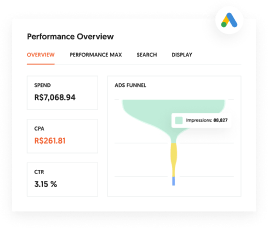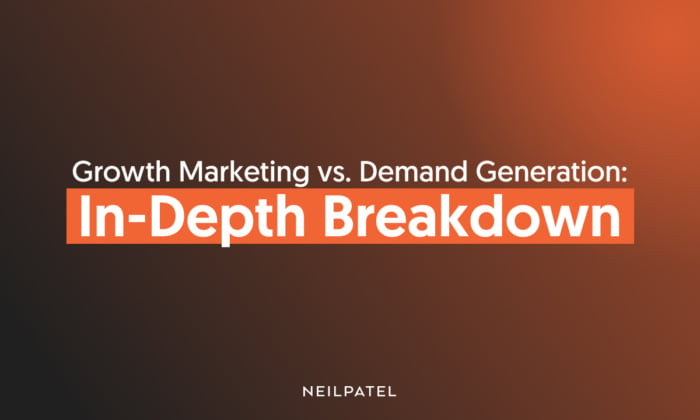
In the dynamic world of digital marketing, terms like growth marketing and demand generation are thrown around like confetti at a New Year’s Eve party. But, let’s hit the pause button for a moment. Are these just trendy buzzwords, or do they represent substantial, distinct strategies that can make or break your business?
Now, you might be thinking, “Aren’t they the same thing with different names?” Well, it’s a common misconception, but the truth is, they’re as different as night and day.
Growth marketing and demand generation have taken the marketing world by storm, promising to elevate your brand and skyrocket your sales. But with so many overlapping tactics and buzzwords flying around, it’s easy to get them tangled up.
In this guide, I’ll unravel these strategies thread by thread, providing you with a clear picture of what each entails, their similarities, and their differences. Ultimately, this post should help you decide which strategy aligns perfectly with your business goals.
So, buckle up, because we’re about to dive deep into the nitty-gritty of growth marketing vs. demand generation!
What Is Growth Marketing?
Growth marketing transforms the traditional marketing model, taking it from a static strategy to a dynamic, holistic approach. We’re not just looking to acquire customers—we’re looking to acquire the right customers. And once we have them, we want to keep them, engage with them, and make them so happy that they can’t help but bring in more customers.
Where old-school methods may stop at the sale, growth marketing sees that as a starting line. It’s about looking at the entire customer journey and optimizing every single touchpoint along the way.
It’s a continuous cycle of attracting, engaging, converting, retaining, and advocating.
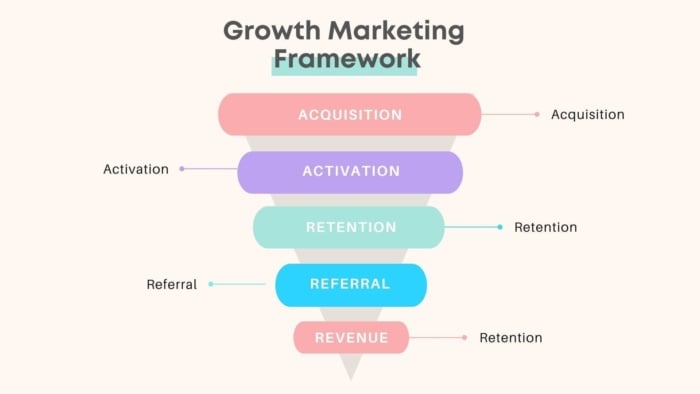
Source: DigitalFirst.ai
Dropbox used growth marketing to take its business to the next level. Its referral program wasn’t just a component of its growth marketing—it was the heart of it. The offer was simple and irresistible: invite your friends and get more storage. Users leaped at the opportunity, spreading the word to everyone in their digital Rolodex. It turned into a snowball effect, with each new user becoming a megaphone for the brand, incentivized by the lure of extra space.
The impact? A tidal wave of growth. In a mere 15 months following the program’s introduction, Dropbox saw sign-ups soar by 60 percent. They went from a modest pool of 100,000 users to a bustling hub of over 4 million. That’s not just growth—that’s a revolution.
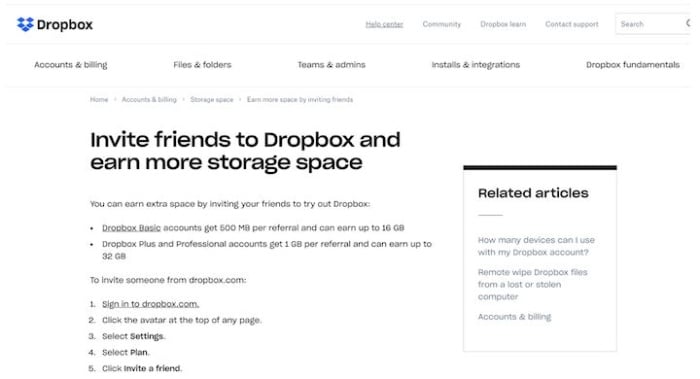
Source: Dropbox
This approach requires a blend of creativity, analysis, and a willingness to experiment. Growth marketers are like the mad scientists of the marketing world, constantly testing, tweaking, and optimizing to find the most effective strategies and channels. They’re not afraid to fail—in fact, they welcome it, because every failure is a step closer to success.
It’s a relentless pursuit of growth, driven by a deep understanding of the customer and a commitment to creating a seamless, personalized experience from start to finish.
Tactics and Channels
The tactics and channels used in growth marketing vs. demand generation differ on many fronts, but they all need to be diverse and adaptable. Here are some of the key strategies used in growth marketing:
- A/B Testing: This is the growth marketer’s bread and butter. We’re not just tinkering around—we’re making data-driven decisions. Did version A of the landing page perform better, or was it version B? We test, we learn, and we grow.
- Content Marketing: Here’s where we get creative. Blogs, videos, infographics, you name it. But it’s not just content for content’s sake—it’s personalized, it’s relevant, and it’s designed to convert.
- Email Marketing: Far from dead, email marketing in the growth marketing world is like a fine wine—it’s only gotten better with time. Segmentation, personalization, automation—these are the tools of the trade.
- Referral Programs: Dropbox’s referral program led to a 60 percent increase in sign-ups. That’s growth marketing in action. We turn customers into advocates and advocates into salespeople.
- SEO: This is where the magic happens. Being visible when and where the customer needs you, with the right content and offer, that’s the goal.
- Social Media: It’s not just about posting updates—it’s about engagement, retargeting, and community building. Social media is a playground for growth hacking.
Measurement
Everything in growth marketing is measurable. If you can’t measure it, you can’t optimize it. Key performance indicators (KPIs) revolve around acquisition, activation, retention, revenue, and referral.
- Acquisition: Where are your users coming from? Tools like Google Analytics come into play here.
- Activation: What actions are users taking on your site? This is where A/B testing shines.
- Retention: How do you keep users coming back for more? This is where tools like Mixpanel make their entrance.
- Revenue: At the end of the day, are users converting to paying customers?
- Referral: Are your customers bringing in more customers? Referral programs and software help track this.
What Is Demand Generation?
Demand generation stands as the grandmaster of the marketing chessboard, calculated, patient, and always thinking ten moves ahead. It’s about building a solid foundation, creating a consistent flow of quality leads, and nurturing relationships over time.
It’s a holistic approach, encompassing everything from brand awareness and lead generation to nurturing and customer retention. But it’s not just about getting any leads—it’s about getting the right leads and guiding them through the customer journey until they’re ready to make a purchase—and then keeping them engaged so they stick around for the long haul.
Hosting a webinar is a great way to ramp up demand and bring in leads. Take my webinar for example, The Future-Ready CMO: Leveraging AI for Strategic Brand Management.
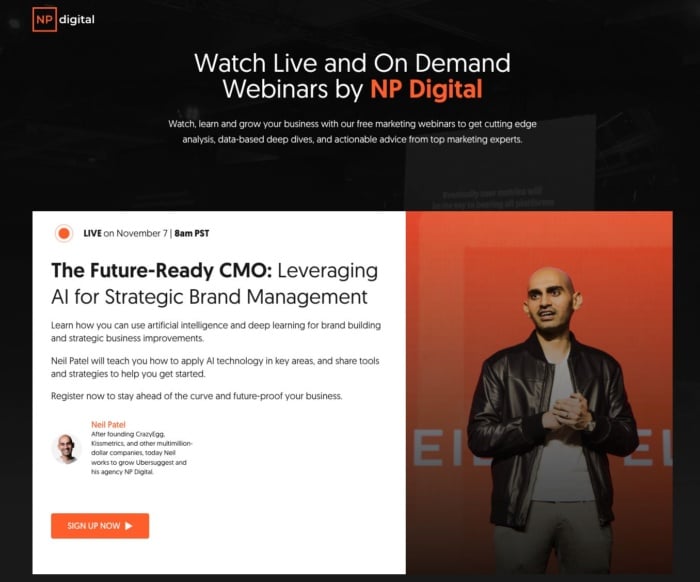
Source: NP Digital
It allows viewers to watch live or on-demand. Either way, they will be part of an email sequence and be categorized in our database for future events as well.
Demand generation is a strategy that requires patience, strategic thinking, and a deep understanding of your target audience. It’s about creating compelling content, utilizing targeted channels, and leveraging data to understand what’s working and what’s not.
It’s not about the quick win—it’s about building a sustainable, reliable engine for growth. It’s a long-term investment in the health and success of your business, ensuring that you’re not just surviving, but thriving, in today’s competitive landscape.
Tactics and Channels
Demand generation requires a sophisticated arsenal of tactics and channels:
- Content Marketing: This is about establishing authority. Whitepapers, webinars, and case studies are the tools of choice.
- SEO and PPC: Visibility is key. Demand gen requires a balanced approach of both paid and organic search strategies.
- Email Marketing: It’s all about nurturing. Drip campaigns and newsletters help keep the relationship warm.
- Events and Webinars: These provide invaluable networking opportunities and help establish credibility.
- Lead Magnets: Offering resources in exchange for contact information—it’s a classic but effective tactic.
- Social Media: Here, it’s more about brand building and thought leadership than direct acquisition.
Measurement
In demand generation, we’re playing the long game, and our metrics reflect that:
- Lead Generation: How many leads are coming through the door?
- Lead Quality: Are they the right leads? Lead scoring systems can help.
- Conversion Rates: Of those leads, how many are converting?
- Customer Lifetime Value (CLV): Over time, what’s the total value of a customer?
- Return on Investment (ROI): At the end of the day, is your strategy paying off?
In both growth marketing and demand generation, data reigns supreme. The tactics, strategies, and end goals might differ, but at their core, both are about building a thriving business. Now, the question is, armed with this knowledge, how will you grow your business?
Growth Marketing vs. Demand Generation: Key Similarities
So, we’ve explored both growth marketing and demand generation, but let’s hit the pause button for a second and talk about where these two strategies shake hands. It’s true, they’re not complete strangers. In fact, they share a considerable amount of common ground, with both being utterly committed to bolstering the business and ensuring a stellar customer journey.
Both strategies may employ similar channels and marketing tactics to achieve desired results. Whether it’s leveraging content marketing to create value, using email campaigns to nurture leads, or optimizing SEO to be found by the right people, these strategies are all about precision and impact.
Growth Marketing vs. Demand Generation: How They Differ
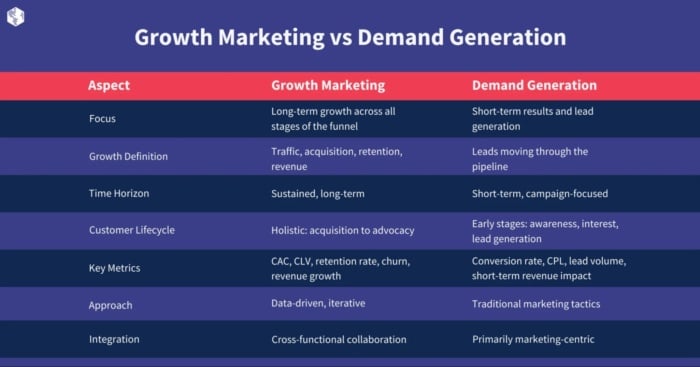
Source: OneIMS
Alright, now let’s talk about the diverging paths of these two strategies. Growth marketing? It’s all about agility, rapid tests, immediate results, and scaling what works—stat. It embodies a startup mentality, irrespective of whether you’re running a fresh, young business or a well-established enterprise.
Demand generation, on the flip side, is nurturing leads meticulously and considering the long-term play. Demand generation crafts stories, builds journeys, and turns prospects into lifelong customers.
Channel-wise, growth marketing is pretty much a chameleon. It adapts, changes, and thrives in whatever environment brings growth, be it social media, SEO, email, you name it. Demand generation, however, is more of a strategist, placing the right content in the right channels to guide prospects through the funnel.
When we talk about measurement, growth marketing is looking at the entire customer journey but with a keen eye on speed and efficiency. Demand generation, meanwhile, is taking a panoramic view, focusing on cultivating long-term relationships and maximizing customer lifetime value.
And if we peek behind the curtain at the team structures, growth marketing squads are agile, ready to jump on the next big thing and experiment their way to success. Demand generation teams, however, balance strategic thinking with tactical execution, patiently nurturing leads until they’re ripe for conversion.
Which Strategy Is Right for You?
So here we are, at the crossroads of your business’s journey. The path you choose now, whether it’s the high-speed highway of growth marketing or the scenic route of demand generation, will set the pace for your company’s future. Let’s delve a little deeper, with real-world scenarios, to help you make the decision.
Imagine you’re running a budding e-commerce platform specializing in quirky, eco-friendly home goods. You need to create a buzz and get products flying off the virtual shelves. You’ve got the agility, you’ve got the moxie—what you need now is growth marketing. Think flash sales, Instagram influencers showcasing your products, and perhaps a clever hashtag challenge that encourages user-generated content and spreads like wildfire.
It’s a playbook similar to what helped propel brands like Gymshark into the limelight.

Source: IIDE.co
On the flip side, say your company has been manufacturing premium kitchen appliances for decades. Your brand is a household name, but the market’s more crowded than ever. Enter demand generation. It’s about reinforcing the legacy while connecting with a new generation. You’ll want to engage in storytelling that highlights your heritage and commitment to quality, much like how Le Creuset leverages its brand history to maintain its premium position.

Source: Le Creuset
Want to combine these two strategies?
Consider a fintech app designed to simplify investments for the everyday person. You can use growth marketing tactics to gain quick adopters through referral bonuses or partnering with personal finance influencers. Then, once you’ve got their attention, you shift gears towards demand generation strategies, like educational webinars and insightful newsletters, to build trust and convert your early adopters into long-term users.
Reflect on your business’s pace, your brand’s voice, and your audience’s expectations. Are you sprinting towards quick growth, or are you running a marathon, pacing yourself for sustained success?
Whatever you decide, know this: there’s no wrong turn here, just different paths to the same destination—growth.
FAQs
Growth marketing is a holistic approach to customer acquisition, retention, and expansion. It’s about finding innovative ways to grow the business, focusing on the entire customer lifecycle. Tactics are varied and agile, measurement is rapid, and the goal is scalable growth.
Demand generation is about creating a steady pipeline of qualified leads. It involves building awareness, establishing authority, and nurturing relationships over time. Tactics are targeted and strategic, measurement is long-term, and the goal is consistent, sustainable business growth.
Consider your business goals, resources, and customer buying cycle. If you need rapid growth and have the agility to experiment, growth marketing might be right for you. If you’re focused on building long-term relationships and have the resources to invest in content and nurturing, demand generation could be a better fit.
Absolutely! Many businesses find success in blending the two strategies, using growth marketing tactics for quick wins and demand generation for long-term stability. It’s all about finding the right balance for your business.
Conclusion
Both growth marketing and demand generation have their places in the digital marketing landscape, each with unique strengths and approaches. Understanding the nuances of each can help you make informed decisions, aligning your marketing strategy with your business goals.
Whether you’re aiming for the stars with rapid growth or playing the long game, building relationships and value over time, there’s a strategy that fits.
So, ask yourself: Are you ready to grow fast, or are you in it for the long haul?

See How My Agency Can Drive More Traffic to Your Website
- SEO - unlock more SEO traffic. See real results.
- Content Marketing - our team creates epic content that will get shared, get links, and attract traffic.
- Paid Media - effective paid strategies with clear ROI.
Are You Using Google Ads? Try Our FREE Ads Grader!
Stop wasting money and unlock the hidden potential of your advertising.
- Discover the power of intentional advertising.
- Reach your ideal target audience.
- Maximize ad spend efficiency.
[ad_2]
Article link

